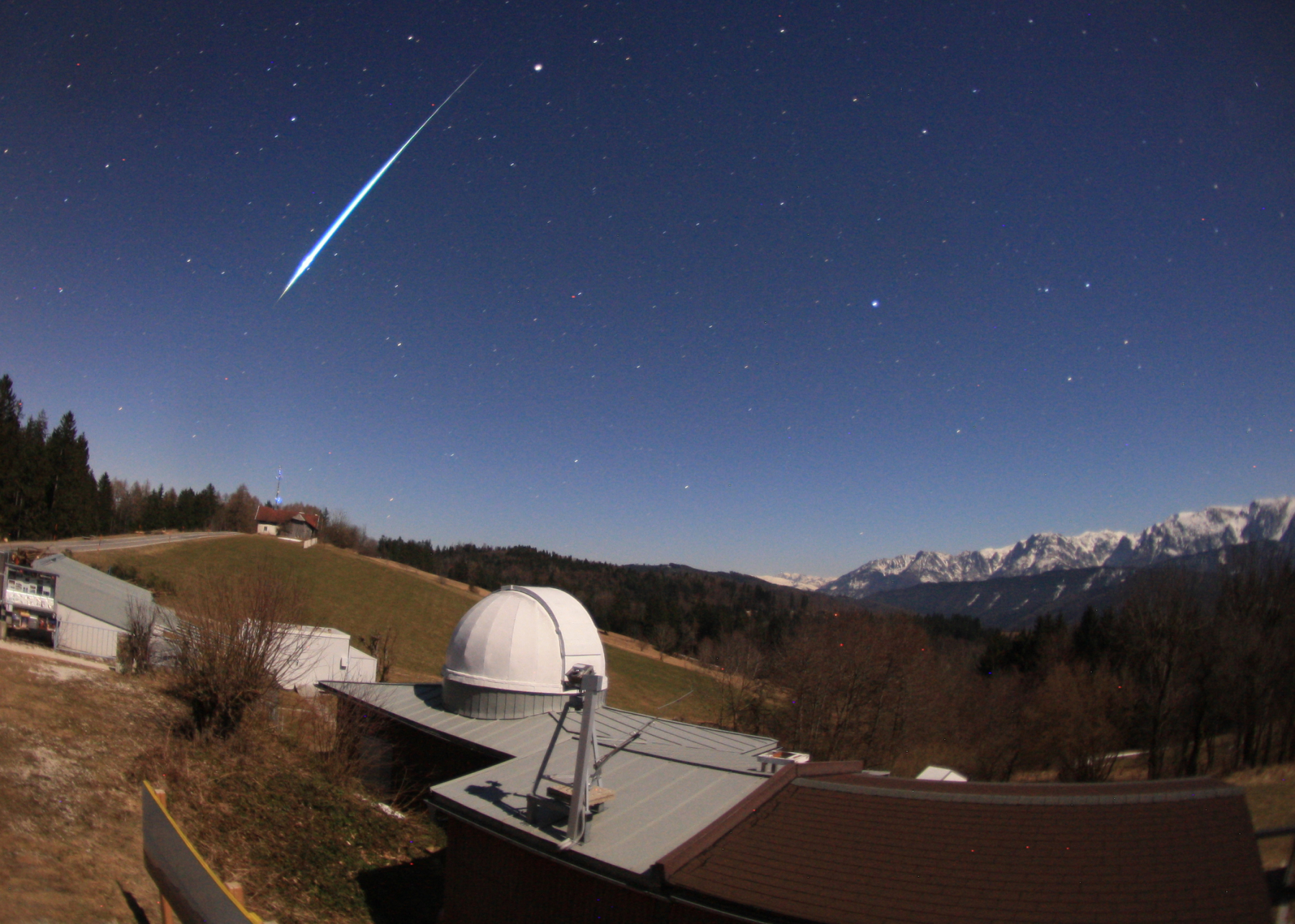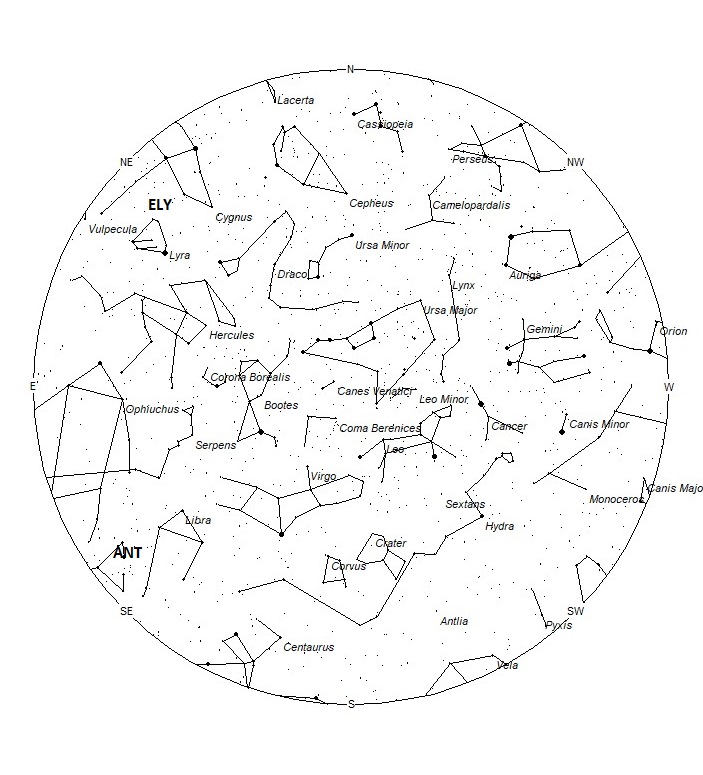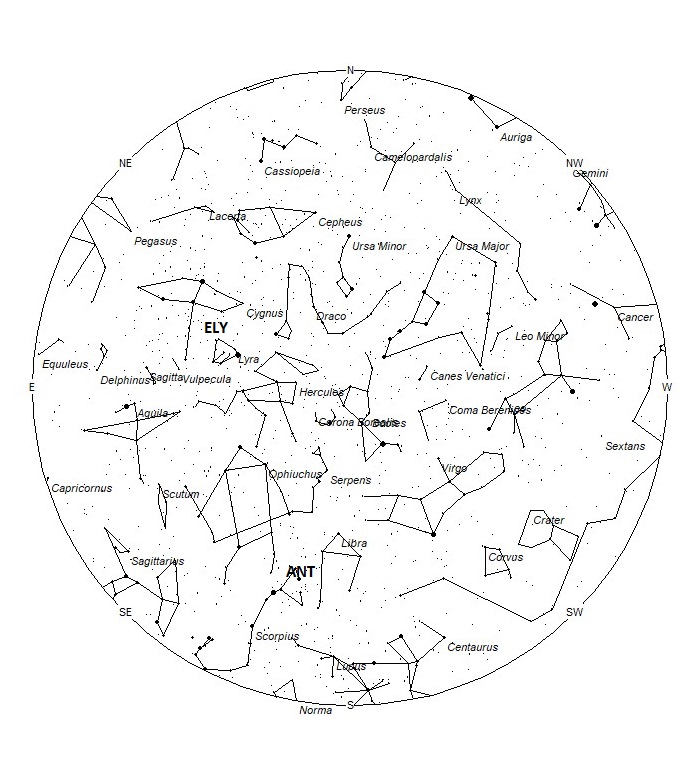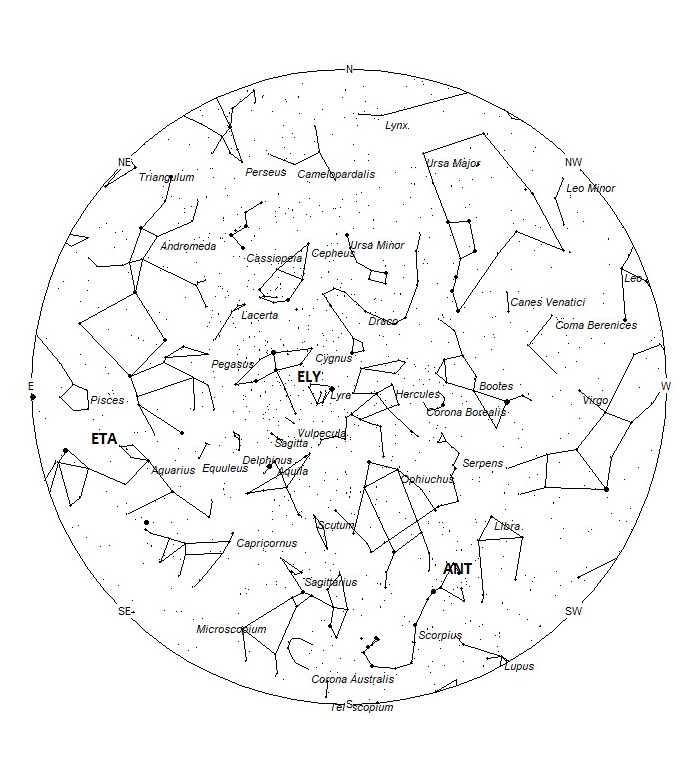 Erwin Filimon captured this fireball on March 13, 2022, at 23:40 CEST (22:40 UT) from near Weyregg am Attersee, Austria. For more information on this event visit: https://fireball.amsmeteors.org/members/imo_view/event/2022/1747 ©Erwin Filimon
Erwin Filimon captured this fireball on March 13, 2022, at 23:40 CEST (22:40 UT) from near Weyregg am Attersee, Austria. For more information on this event visit: https://fireball.amsmeteors.org/members/imo_view/event/2022/1747 ©Erwin FilimonDuring this period, the moon reaches its first quarter phase on Sunday May 8th. At that time the moon is located 90 degrees east of the sun and will set around 02:00 local daylight saving time (LDST) on May 9th. As the week progresses, the moon will interfere more with meteor observing during the more active morning hours as it waxes in phase and sets later each morning. For evening observers, the estimated total hourly rates should be near 3 as seen from mid-northern latitudes (45N) and 4 as seen from tropical southern locations (25S) For morning observers, the estimated total hourly rates should be near 18 as seen from mid-northern latitudes (45N) and 27 as seen from tropical southern locations (25S). Evening rates are reduced due to moonlight. The actual rates will also depend on factors such as personal light and motion perception, local weather conditions, alertness, and experience in watching meteor activity. Note that the hourly rates listed below are estimates as viewed from dark sky sites away from urban light sources. Observers viewing from urban areas will see less activity as only the brighter meteors will be visible from such locations.
The radiant (the area of the sky where meteors appear to shoot from) positions and rates listed below are exact for Saturday night/Sunday morning May 07/08. These positions do not change greatly day to day so the listed coordinates may be used during this entire period. Most star atlases (available at science stores and planetariums) will provide maps with grid lines of the celestial coordinates so that you may find out exactly where these positions are located in the sky. I have also included charts of the sky that display the radiant positions for evening, midnight, and morning. The center of each chart is the sky directly overhead at the appropriate hour. These charts are oriented for facing south but can be used for any direction by rotating the charts to the desired direction. A planisphere or computer planetarium program is also useful in showing the sky at any time of night on any date of the year. Activity from each radiant is best seen when it is positioned highest in the sky, either due north or south along the meridian, depending on your latitude. It must be remembered that meteor activity is rarely seen at the radiant position. Rather they shoot outwards from the radiant, so it is best to center your field of view so that the radiant lies at the edge and not the center. Viewing there will allow you to easily trace the path of each meteor back to the radiant (if it is a shower member) or in another direction if it is sporadic. Meteor activity is not seen from radiants that are located far below the horizon. The positions below are listed in a west to east manner in order of right ascension (celestial longitude). The positions listed first are located further west therefore are accessible earlier in the night while those listed further down the list rise later in the night.
These sources of meteoric activity are expected to be active this week.
.
The large Anthelion (ANT) is currently centered at 16:00 (240) -21. This position lies in western Scorpius, 2 degrees north of the 2nd magnitude star known as Dschubba (delta Scorpii). Due to the large size of this radiant, these meteors may also be seen from southwestern Ophuichus and eastern Libra as well as western Scorpius. This radiant is best placed near 02:00 LDST when it lies on the meridian and is highest in the sky. Rates at this time should be near 2 per hour as seen from the Northern Hemisphere and 3 as seen from south of the equator. With an entry velocity of 30 km/sec., the average Anthelion meteor would be of slow velocity.
The eta Lyrids (ELY) are active from May 3-14 with maximum activity occurring on the 10th. The radiant is currently located at 19:21 (290) +43. This area of the sky is located in northeastern Lyra, 3 degrees northeast of the 4th magnitude star known as eta Lyrae. The radiant is also located 8 degrees northeast of the brilliant zero magnitude star known as Vega (alpha Lyrae). This radiant is best placed during the last hour before dawn when it lies highest above the horizon in a dark sky. Current rates are expected near 1 per hour as seen from the Northern Hemisphere and less than 1 and seen from south of the equator. These meteors are not well seen from locations south of the equator as the radiant does not rise very high into the northern sky. With an entry velocity of 45 km/sec., the average meteor from this source would be of medium velocity.
The eta Aquariids (ETA) are currently active from a radiant located at 22:42 (340) +00. This area of the sky is located in northeastern Aquarius, 2 degrees east of the 4th magnitude star known as eta Aquarii. These meteors are not visible prior to 0200 LDST and are best seen just before the start of dawn when the radiant lies highest in a dark sky. Hourly rates are expected to decrease this week from 15 per hour down to 3 by Friday. With an entry velocity of 66 km/sec., the average meteor from this source would be of swift velocity.
As seen from the mid-northern hemisphere (45N) one would expect to see approximately 5 sporadic meteors per hour during the last hour before dawn as seen from rural observing sites. Evening rates would be near 2 per hour. As seen from the tropical southern latitudes (25S), morning rates would be near 9 per hour as seen from rural observing sites and 3 per hour during the evening hours. Locations between these two extremes would see activity between the listed figures.
The list below offers the information from above in tabular form. Rates and positions are exact for Saturday night/Sunday morning except where noted in the shower descriptions.
| SHOWER | DATE OF MAXIMUM ACTIVITY | CELESTIAL POSITION | ENTRY VELOCITY | CULMINATION | HOURLY RATE | CLASS |
| RA (RA in Deg.) DEC | Km/Sec | Local Daylight Saving Time | North-South | |||
| Anthelions (ANT) | – | 16:00 (240) -21 | 30 | 02:00 | 2 – 3 | II |
| eta Lyrids (ELY) | May 10 | 19:21 (290) +43 | 43 | 05:00 | 1 – <1 | II |
| eta Aquariids (ETA) | May 05 | 22:42 (340) +00 | 66 | 09:00 | 10 – 15 | I |
 American Meteor Society
American Meteor Society


